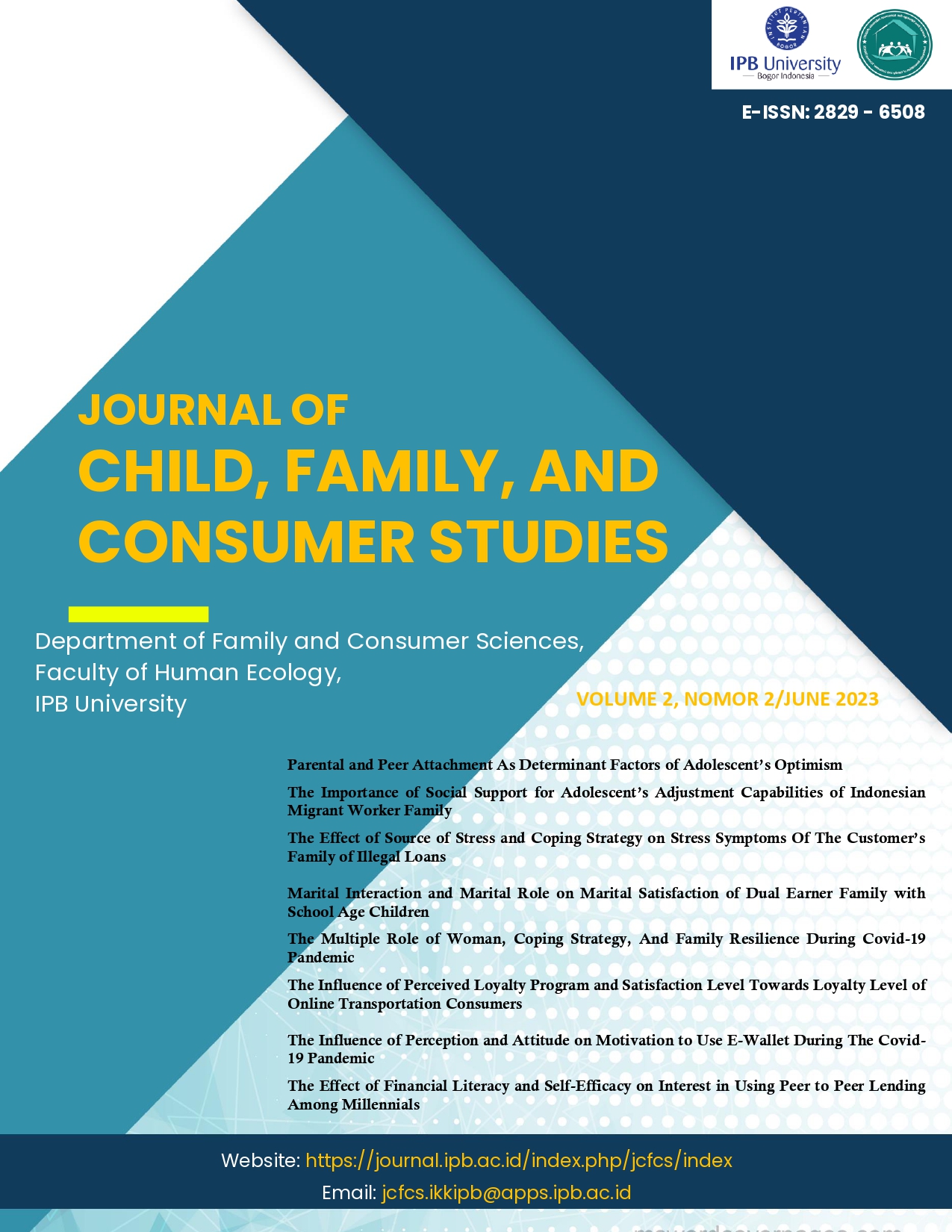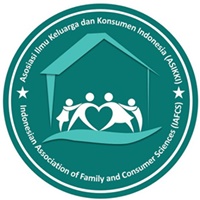PARENTAL AND PEER ATTACHMENT AS DETERMINANT FACTORS OF ADOLESCENT’S OPTIMISM
Abstract
An optimistic life is important to everyone. An external factors that contributes to life optimism of adolescent are interactions with parents and peers. This study aims to analyze the influence of adolescent’s and family’s characteristics and parental and peer attachment on adolescent's optimism in life. This study used a cross-sectional research method in senior high schools and vocational schools located in Bekasi City, West Java. Total of 256 students were participated in the study. The results showed that most adolescents had a secure attachment to their parents and peers,and a high degree of optimism in life. The study also found that parent-child attachment has a significant positive relationship and influence on teeanger's life optimism. Further analysis showed that the mother-peer attachment model had a higher influence on teeanger's life optimism than the father-peer attachment model, although both models has significant influence.
References
Agustika, I. W. P., Hary, TA. P. A. (2012). Pengaruh optimisme dan empati terhadap efikasi diri siswa sekolah sepak bola (SSB) Baturetno Banguntapan Yogyakarta. Jurnal SPIRITS. 3(1), 52-64. https://doi.org/10.30738/spirits.v3i1.1125
Aidina, W., Nisa, H., & Sulistyani, A. (2013). Hubungan antara penerimaan diri dengan optimisme menghadapi masa depan pada remaja di panti asuhan. Jurnal Psikohumanika. 4(2), 1-12.
Adilia, M. D. (2010). Hubungan self esteem dengan optimisme meraih kesuksesan karir pada mahasiswa Fakultas Psikologi UIN Syarif Hidayatullah Jakarta (Undergraduate Thesis). Diambil dari http://repository.uinjkt.ac.id.
Anggoro, P. (2017). Faktor penyebab penyalahgunaan napza di kalangan remaja instalasi rehabilitasi wisma sirih. Jurnal Pendidikan dan Pembelajaran Khatulistiwa. 6(6).
Appleyard, K., Berlin, L. J. (2007). Supporting healthy relationship between young children and the parents. Center For Child and Policy Duke University. Diambil dari https://childandfamilypolicy.duke.edu/pdfs/pubpres/SupportingHealthyRelationships.pdf.
Arif, F., Wahyuni, S. (2017). Hubungan kelekatan pada ibu, ayah, dan teman sebaya dengan kecenderungan anak menjadi pelaku dan korban bullying. Jurnal Psikologi Ulayat. 4(2), 122-140. doi 10.24854/jpu22017-100.
Armsden, G., Greenberg, M. T. (1987). The inventory of parent and peer attachment: individual different and their relationship to psychological well-being in adolescence. Journal of Youth and Adolescence. 16, 427-454.
Berkman, L. F., Syme, S. L. (1979). Social networks, host resistance, and mortality: a nine-year follow-up study of Alameda County residents. American journal of epidemiology, 109(2), 186–204. https://doi.org/10.1093/oxfordjournals.aje.a112674.
Balluerka, N., Gorostiaga, A., Arbiol, I. A., & Aritzeta, A. (2016). Peer attachment and class emotional intelligence as predictors of adolescents’ psychological well-being: a multilevel approach. Journal of Adolescence. 53:1-9. doi:10.1016/j. adolescence.2016.08.009.
Bretherton, I. (1992). The origin of attachment theory : John Bowlby and Mary Ainsworth. Development Psychology. 28(5), 759-775.
Daraei, M., Ghaderi A. R. (2012). Impact of Education on Optimism/Pessimism. Journal of the Indian Academy of Applied Psychology. 38(2), 339-343.
Deborah, J. L., Gustav, C., & Marcela, R. (2000). The differential relations of parent and peer attachment to adolescent adjustment. Journal of Youth and Adolescence. 29(1), 45–59.
Elmanora. (2012). Kesejahteraan keluarga petani kayu manis. Jurnal Ilmu Keluarga dan Konsumen. 5(1), 58-66.
Goleman, D. (2005). Emotional Intelligence : Why It Can Matter More Than IQ. New York : Bantam Dell.
Gorrese, A., Ruggieri, R. (2012) Peer attachment: a meta-analytic review of gender and age differences and associations with parent attachment. Journal Youth Adolescence. 41, 650-672. doi 10.1007/s10964-012-9759-6.
Gottfredson, M. R., Hirschi, T. (1990). A general theory of crime. Standford CA: Standford University Press.
Hardani, R. (2017). Pengaruh kelekatan anak dengan orang tua, guru, teman dan kontrol diri terhadap perilaku pornografi anak SMP (Master’s thesis). Retrieved from https://repository.ipb.ac.id/handle/123456789/87433
Hardani, R., Hastuti, D., & Yuliati, L. N. (2017). Kelekatan anak dengan ibu dan ayah serta perilaku pornografi pada anak usia smp. Jurnal Ilmu Keluarga & Konsumen. 10(2), 120-131. doi:http://dx.doi.org/10.1016/j.copsyc.2017.02.006.
Heydari, A., Teymoori, A., & Nasiri, H. (2015). The effect of parent and peer attachment on suicidality: The mediation effect of self-control and anomie community. Mental Health Journal. 51(3), 359-364. doi : http : // dx. doi. org/ 10.1007/ s10597 -014-9809-5.
Hurlock, E. B. (1980). Psikologi Perkembangan Suatu Pendekatan Sepanjang Rentang Kehidupan Edisi Kelima. Istiwidayanti, Soedjarwo, penerjemah; Sijabat RM, editor. Jakarta, ID: Penerbit Erlangga. . Terjemahan dari: Development Psychology A Life-Span Approach , Fifth Edtion.
I.D. Into The Light. (2019). Bunuh diri sebagai masalah kesehatan global : data dan fakta terbaru. Diambil dari https://www.intothelightid.org/tentang-bunuh-diri/bunuh-diri-sebagai-masalah-kesehatan-global-data-dan-fakta-terbaru.
Kamaratih, D., Ruhaena, L., & Prasetyaningrum, J. (2016). Pelatihan berpikir optimis untuk meningkatkan orientasi masa depan remaja. Jurnal Intervensi Psikologi. 2 (8), 250-262. doi: 10.20885/intervensipsikologi.vol8.iss2.art7.
[KEMENKES] Kementerian Kesehatan Republik Indonesia (2018). Hasil Utama Riset Kesehatan Dasar 2018.
Lestari, D. A., Satwika, Y. W. (2018). Hubungan antara peer attachment dengan regulasi emosi pada siswa kelas VIII di SMPN 28 Surabaya. Character : Jurnal Penelitian Psikologi. 5(2).
Lu, A., Yu, Y., Hong, X., Feng, Y., & Tian, H. (2014). Peer attachment and loneliness among adolescents who are deaf : the moderating effect of personality.
McGinnis, A. L. (1995). Kekuatan Optimisme : Rencana Tindakan untuk Menggali yang Terbaik dari Diri Sendiri. Anton Adiwiyoto, penerjemah. Jakarta (ID): Mitra Utama. Terjemahan dari : The Power of Optimism.
Mota, C. P., Matos, P. M. (2013). Peer attachment, coping, and self-esteem in institutionalized adolescents: the mediating role of social skills. Journal of Psychology Education, 28, 87-100.
Mumtanah, Arianti, J. (2016). Hubungan antara kelekatan terhadap teman sebaya dengan kematangan karir pada siswa kelas XI SMK Negeri 1 Trucuk Klaten. Jurnal Empati. 5(4), 705-710.
Nurhidayah, S. (2011). Kelekatan (attachment) dan pembentukan karakter. Turats (Jurnal Pemikiran dan Peradaban Islam). 7(2), 78-83.
Nurhidayah, S. (2013). Ketahanan keluarga, pengasuhan, dan intervensi sosial, serta pengaruhnya terhadap perkembangan psikososial remaja pada keluarga miskin di Kota Bekasi (Master’s thesis). Bogor (ID): Institut Pertanian Bogor.
Peltzer, K., Pengpid, S. (2018). High prevalence of depressive symptoms in a national sample of adults in Indonesia: childhood adversity, sociodemographic factors and health risk behaviour. Asian Journal of Psychiatry, 33, 52-59. doi: 10.1016/j.ajp.2018.03.017.
Prastisti, W. D., Helmi, A. F. (2014). Dimensi optimisme pada remaja. Prosiding Seminar Nasional Psikometri. 139-147.s
Purnama, R. A., Wahyuni, S. (2017). Kelekatan (attachment) pada ibu dan ayah dengan kompetensi sosial pada remaja. Jurnal Psikologi UIN Sultan Syarif Kasim. 13(1), 30-40.
[PUSDATIN] Pusat Data dan Informasi Kementerian Kesehatan Republik Indonesia 2014. Buletin Penyalahgunaan Narkoba di Indonesia.
Putri, A. R., NRH, F. (2015). Self esteem dan optimisme raih kesuksesan karir pada fresh graduate Fakultas Teknik Universitas Diponegoro. Jurnal Empati. 4(4), 15-19.
Retnaningsih. (2005). Peranan kualitas attachment, usia dan gender pada perilaku prososial. Prosiding Seminar Nasional PESAT. 9-17.
Rini, L., Siswati. (2017). Hubungan antara regulasi diri dengan optimisme pada warga binaan yang menjadi pekerja pembantu di Lembaga Pemasyarakatan Perempuan Klas II A Semarang. Jurnal Empati. 7(3) : 297-302.
Roellyana, S., Listiyandini, R. A. (2016). Peranan optimisme terhadap resiliensi pada mahasiswa tingkat akhir yang mengerjakan skripsi. Prosiding Konferensi Nasional Peneliti Muda Psikologi Indonesia. 1(1), 29-37.
Sari, S. L., Devianti, R., & Safitri, N. (2018) Kelekatan orang tua untuk pembentukan karakter anak. Educational Guidance and Couseling Development Journal. 1(1), 17-31.
Sari, D. L., Widiani, E., Trishinta, S. L. (2019) Hubungan pola pikir pesimisme dengan resiko depresi pada remaja. Nursing News. 4(1), 88-99.
Santrock, J. W. (2003). Adolescent Perkembangan Remaja. Shinto BA, Sherly S, penerjemah; Wisnu C. K., Yati S., editor. Jakarta (ID): Erlangga. Terjemahan dari: Adolescence. Ed ke-6.
Scheier, M. F., Carver, C. S. (1987). Dispositional optimism and physical well-being: The influence of generalized outcome expectancies on health. Journal of Personality. 55, 169-210.
Scheier, M. F., Carver, C. S. (1992). Effect of optimism on psychological and physical well-being: theoretical overview and empirical update. Cognitive Therapy and Research. 16(2), 201-228.
Seligman, M. E. P. (2008). Menginstal Optimisme. Budhy Yogapranata, penerjemah; Tim Salamandani, editor. Bandung (ID): Momentum. Terjemahan dari : Learned Optimism How To Change Your Mind and Your Life.
Situmorang, Z. R. D., Hastuti, D., & Herawati, T. (2016). Pengaruh kelekatan dan komunikasi dengan orang tua terhadap karakter remaja perdesaan. Jurnal Ilmu Keluarga & Konsumen. 9(2), 113-123.
Shobabiya, M. (2014). Hubungan antara kelekatan orang tua dengan risiko penyalahgunaan NAPZA pada remaja. Naskah Publikasi Skrispi. Surakarta : Fakultas Psikologi Universitas Muhammadiyah Surakarta.
Slamet. (2014). Pelatihan motivasi berprestasi guna meningkatkan efikasi diri dan optimisme pada mahasiswa aktivis organisasi di UIN Sunan Kalijaga Yogyakarta. Jurnal Hisbah. 11(1).
Suseno, M. N. (2013). Efektivitas pembentukan karakter spiritual untuk meningkatkan optimisme terhadap masa depan anak yatim piatu. Jurnal Intervensi Psikologi. 5(1), 1-24.
Tambunan, S. (2018). Hubungan antara optimisme dengan adversity quotient pada mahasiswa Fakultas Psikologi Universitas Medan Area yang bekerja (Undergraduate Thesis). Medan (ID) : Universitas Medan Area.
Tangney, J., Baumeister, R. F., & Boone, A. L. (2004). High self-control predicts good adjustment, less pathology, better grades, and interpersonal success. Journal of personality. 72, 271–324.
Taufik, A. (2013). Persepsi remaja terhadap perilaku seks pranikah (studi kasus SMK Negeri 5 Samarinda). E-Journal Sosiatri-Sosiologi. 1(1), 31, 44.
Vivona, J. M. (2000). Parental attachment styles of late adolescents: qualities of attachment relationships and consequences for adjustment. Journal of Counseling Psychology. 47(3), 316-329. doi: 10.1037MX)22-0167.47.3.316.
Whiteford, H. A., Degenhardt, L., Rehm, J., Baxter, A. J., Ferrari, A. J., Erskine, H. E., Carlson, F.J, Norman, R.E., Flaxman, A.D., Johns, N., Burstein, R., Murray, C.J.L., & Vos, T. (2013). Global burden of disease attributable to mental and substance use disorders: findings from the Global Burden of Disease Study 2010. The Lancet. 382(9904), 1575–1586. doi.org/10.1016/S0140-6736(13)61611-6.
[WHO] World Health Organization (2014). Preventing Suicide A Global Imperative. Luxembourg: WHO Library Cataloguing-in-Publication Data.
[WHO] World Health Organization (2019). Suicide in The World. Licence: CC BY-NC-SA 3.0 IGO.
Winarti, A., Cholilawati, C., Istiany, A. (2014). Hubungan kelekatan orang tua dengan anak terhadap kecerdasan emosional remaja laki-laki di SMP. JKKP (Jurnal Kesejahteraan Keluarga dan Pendidikan). 1(2), 70-77.
Yosep, I. (2007). Keperawatan Jiwa. Bandung : Refika Aditama.










